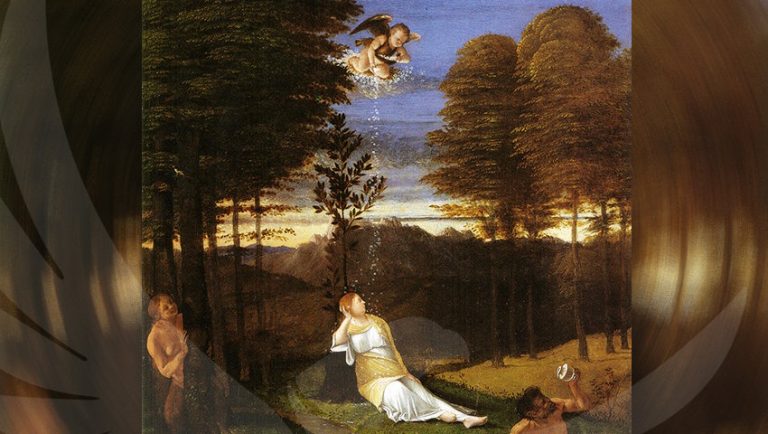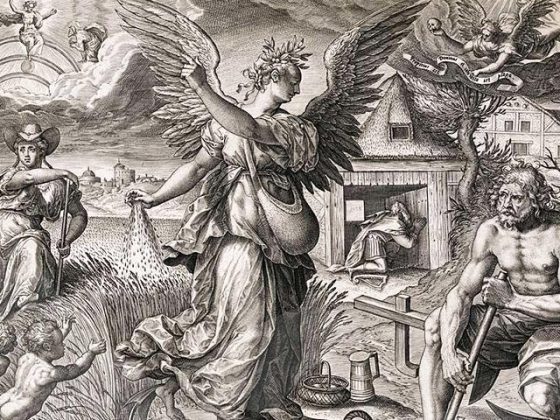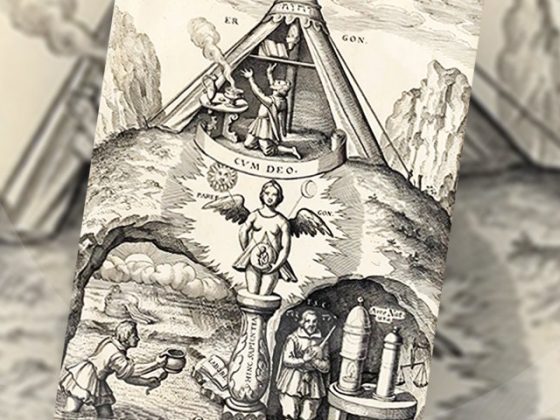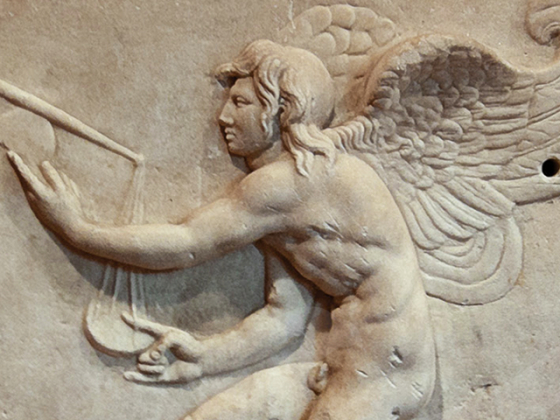Dearly beloved readers:
I am glad to send you this oil painting by an artist named Lorenzo Lotto, from the time of 1505. This work is preserved in the National Gallery of Art in Washington.
The title of this artistic work is…
…ALLEGORY OF CHASTITY
OR Allegory Of The Vigilant Sleep Of The Soul
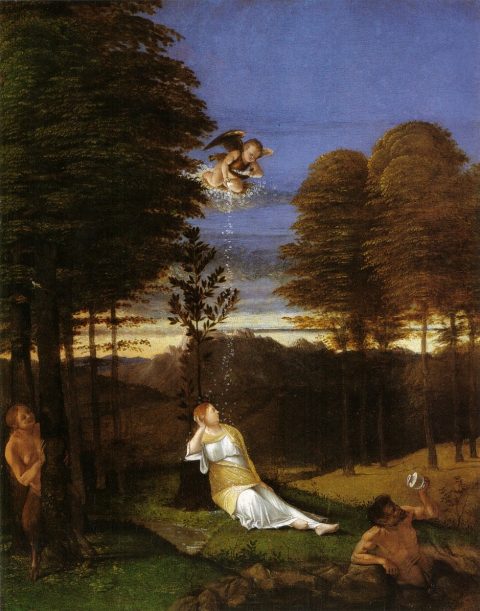
Let us start by observing a wide wooded landscape which sets the background of the scene with the glow of the sunset.
In the centre, clothed by a mysterious light, we see a young woman barefoot and dressed in a white robe, matching a golden cloak, leaning gently against the trunk of a laurel tree with two stems, all of which is reminiscent of the mythological figure of Daphne and her contingency. It is in tune with the feeling of stillness, a suspended state of purifying vision that is far from the unconscious abandonment of sleep. Above, over the young woman, a little angel pours over her a cascade of white flowers, perhaps an allusion to Petrarch's poetry: “Chiare, fresche et dolci acque”, “Clear, fresh and sweet waters”.
Two satyrs, a female appearing behind a tree on the left, and a male lying down and observing a glass jug on the right in the foreground near a pond, respectively represent the snares of carnal love and drunkenness, which the maiden is ignoring. The originality of these elements and the compositional freedom demonstrate the inventiveness and irony typical of the artist Lotto.
The painting testifies that its author knew the theme of sleeping vigil, a motto regarding psychological and alchemical self-observation.
What does this beautiful work of art really enclose?
In the damsel reclining on the trunk of a laurel tree we can appreciate the symbol of the soul ─clothed with a human body─ remaining indifferent to the desires of the animal Ego that caused the famous angelic fall millions of years ago.
That act turned the Lemurian inhabitants into lustful satyrs who, unfortunately, by such an act lost the purification they originally possessed and since then, already fallen into disgrace, the Law of Return and Recurrence has trapped them in the famous Wheel of Samsara of Hindustani theogony. Through the Gnostic teachings it is possible to retake this inner angelic state with the application of the three factors of the Revolution of the Consciousness, namely: death of the “I”, second birth – an alchemical term – and sacrifice for humanity.
This has nothing to do with Catholic abstinence, which has produced so many disorders in the human race. It is rather a sacred sexuality practiced by the human masses just before the angelic rebellion cited by the religious creeds of our world, today quite far from the harsh reality that happened to our race.
The ancient and sacred texts emphasize that, indeed, in those remote times, Luciferian people wandered through many places trying to convince other people of how wonderful fornication is; an abomination, without a doubt.
Another very curious detail is the one that allows us to see the male satyr pouring the hermetic jug or glass ─symbol of the female yoni─ to enrich his own lust. This allows us to intuit that the artist knew thetransmutatory ars of the genetic waters, which allows the human creature to attain his own total regeneration.
The little angel who drops a cascade of white flowers allegorizes in this case the protection enjoyed by regenerated souls, and for this reason it is Cupid himself who keeps them protected with his true love… Certainly, CONSCIOUS LOVE is a valid armor to face the Mayavic-illusory world that keeps the minds of our human anthill alienated.
Note that in both satyrs their lower limbs are similar to those of the goat, due, precisely, to the animality in which they have been trapped.
Let us not forget, on the other hand, that the laurel tree has wonderful magical qualities, and the fact that the damsel in our oil painting is reclining on its trunk indicates that she is associated with this magic because her animic nature is still free from the stain of sin.
I now send you some sentences that are in accordance with this theme that this painting presents to us, let us see:
“If chastity is not a virtue, it is certainly a force.”
Jules Renard
“The abundance of love produces the treasure of chastity.”
Rabindranath Tagore
“Consciousness is the voice of the soul; the passions that of the body. Consciousness has more than a thousand tongues.”
Shakespeare
“There was never yet fair woman but she made mouths in a glass.”
Shakespeare
“The first kiss, you know, is not given with the mouth but with the eyes.”
Paul Bernard
MEMENTO MORI.
─‘Remember that one day you will die’─.
KWEN KHAN KHU


